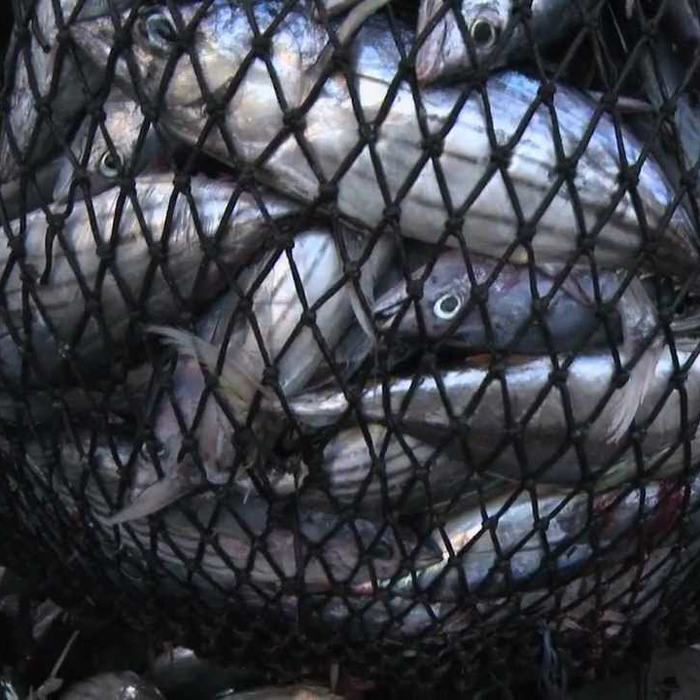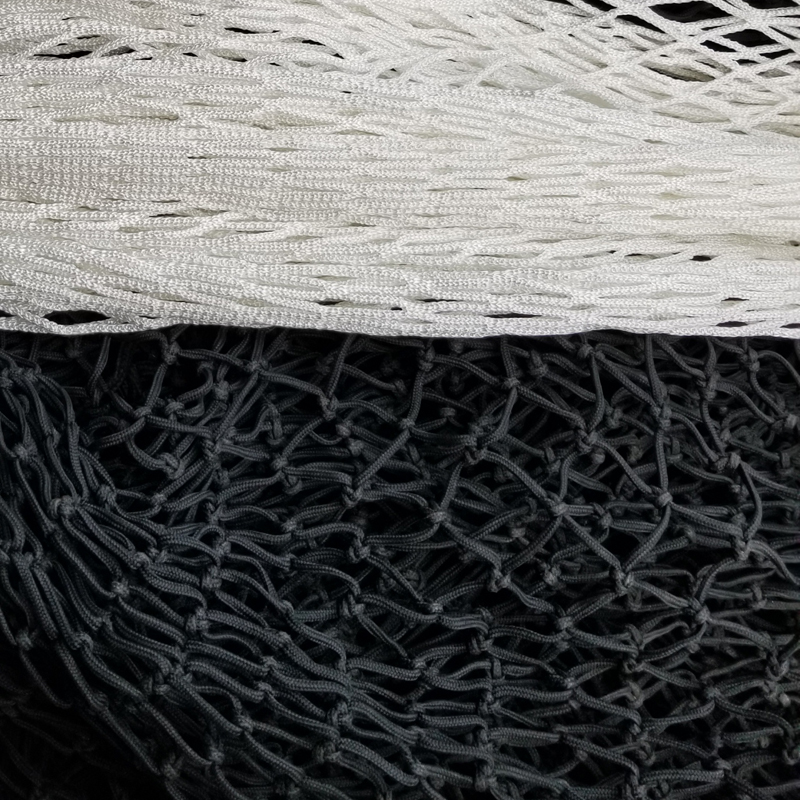| Item Name | Purse Seine Fishing Nets Bluefin Tuna Cage |
| Item No. | HX2106 |
| Material | Nylon |
| Color | Black, white |
| Construction | Braided knotted, knotless |
| Mesh Size | 100mm full |
| Others | Custom nets and accessories are available. |
Weihai Huaxing Nets provide high quality Purse Seine Fishing Nets Bluefin Tuna Cage for all over the world. All the above dimensions can be customized.
Product Features
*Material: nylon
*Mesh size: 100mm full
*Type: Braided knotted, knotless
*Colour: Black, white
*Tear resistant mesh netting
Fishery Overview
The industrial fleets worldwide have become increasingly mobile, with vessels changing ocean areas in reponse to changing catch rates, market prices and operating costs. These movements are typical for super seiners which for example, after a successful fishing season in the west Indian Ocean, can return to the eastern Atlantic Ocean to continue fishing off the West African coast, or to the Pacific and the east Indian ocean to fish off Japan or in the EEZ waters of the Pacific island nations. The introduction of the extended economic zones (EEZs), confronted the tuna fishery with the necessity of purchasing fishing rights. Access to some of the EEZs had been free, but now had to be paid for.
Fishing Operations
The fishing operations realized by a purse seiner to catch tuna, from the beginning of the shooting of the net up to the end of the hauling, back on board of the seine (ready for a new shooting), are called a “set”. There have been so-called dolphin set, in which case the net is set and fish schools associated with certain species of dolphins are herded into the net using 2-3 speed boats. When the school is inside of the net, the end of the net is closed and the bottom is pursed.
| 1. When a school is detected, the vessel places itself on the right side of the school (most of the tuna purse seiners have deck arrangement for operating from the left side, but not all the vessels have the same). For the correct positioning of the vessel versus the fish school, the direct observation from the crows nest, at the top of the mast, is essential (as it was also before for the detection/location of fish from signs at or over the surface of the sea, including seabirds). The skiff, a highly powered annex, attached to one extremity of the purse seine and having one extremity of the purse line cable (whereas the other extremity of this cable is attached to the winch on the purse seiner) which is kept on the top of the net at the sloped part of the stern of the vessel, is released. |
| 2. The vessel then encircles the school at maximum speed. Usually, all the purse seine is set and the circle is closed within 4 to 8 minutes. In the Mediterranean Sea, purse seiners fishing northern bluefin tuna often do not shoot all the length of the seine and close the circle with only a portion of the net. At this time, tunas can change their direction and escape before the circle is closed. In the eastern Pacific Ocean, purse seiners often set on tuna school associated with certain species of dolphins. In this so-called dolphin set, the net is set across the direction where the school is moving towards and fish schools associated with dolphins are herded into the net using 3 to 5 speed boats. When the school is inside of the net, the end of the net is closed and the bottom is pursed. In the last several years, the use of fish aggregating devices (FAD) is getting very popular in all the oceans. Each vessel set several FADs in the ocean with radio buey to locate it. Some of them even have fish detecting device and transmit the information of the conditions gathering the fish under the device to the fishing vessels. When enough fish are gathered, the boat sets the net around the FAD to catch everything under. Frequently drifting baitboats are used in place of FADs. |
| 3. Once the encirclement is finished, the extremity of the net that stayed attached to the skiff is transferred aboard the purse seiner and the two extremities of the purse line cable are hauled with the winch as quickly as possible in order to close the net at its bottom (this is called “pursing” because it is similar to pulling the draw string of an old-fashioned purse). It is worth observing that, until the purse seine is not closed, the tunas can still dive below the net or the purse seine vessel and escape. If the net stays from the surface all the way down to the thermocline, the chance of fish escape from the bottom would be minimal. During the pursing, and especially when there is current, in order to prevent the purse seiner from drifting over the net, the skiff is attached to the starboard side of the vessel and pulls it away from the net. In the Eastern Central Pacific area, when the set is made on the school associated with dolphins, a special operation, known as the “backdown operation” is realized at this time in order to let a par of the float line submerge in the water so that dolphins having been trapped in the purse seine can be released through that section. Speed boats are used to hep release operation. The pursing may take for large purse seines around 15 to 20 minutes. |
| 4. The net is then pulled aboard the purse seiner with ahydraulic power block which is, on board industrial purse seiners, attached to the end of the boom and hanging above the deck, on medium size vessels operated at the extremity of a crane fixed on the deck at the aft part. Under the power block, the net is stacked on the stern of the boat by fishermen in such a way that it will come smoothly off the stern at the beginning of the next set. As a whole, this operation will, if there is no incident, take around one hour (minor incidents are not uncommon during the fishing operation) or even longer, depending on the size of the net and catch. |
| 5. When most of the purse seine has been retrieved, the tunas have been grouped within a restricted area along the portside of the vessel. Then the fish are harvested from the purse seine using a large scoopnet called the “brailer” (brailing operation); several tonnes of fish are taken on board each time. The duration of this operation will obviously depend upon the quantity of fish in the net. In the bluefin tuna fishing in the Mediterranean Sea, and southern bluefin tuna fishing off Australia, the pursing is stopped a half way, where the fish are not yet so much aggregated. This is to keep the fish well alive, as most of the live fish caught are transferred to transport cage for tuna farming. |
| 6. The tunas go towards fish-wells through trays and tubes arranged in the deck. In the fish-well fish are in brine which cools the fish without delay and freeze it for long conservation at -20 °C or even lower. |
Fishery Production Systems
Purse seining for tuna is a fishing technique used all around the world by the industrial and semi-industrial fleets of several countries.
Please contact us if any questions, our sales team will always be happy to provide you with the most professional info.


